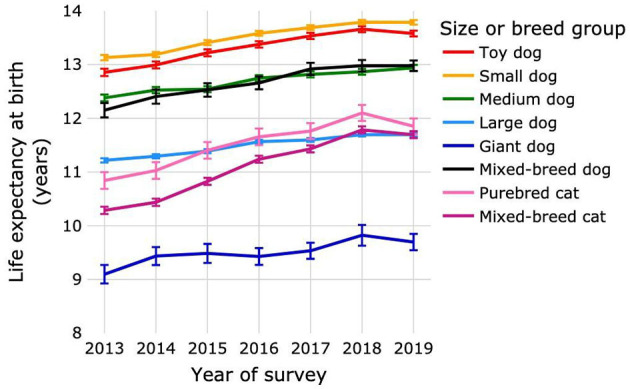No.
Well, that could easily be the shortest SkeptVet blog post ever, but I guess I can’t really leave it there. For one thing, the answer should really be, “Almost certainly no,” since my level of confidence is high but not absolute. Secondly, it’s the wrong question to be asking, and not one in which I have any interest.
The subject has come up because of some recent publicity around my work with Loyal, a biotechnology company working towards FDA approval for drugs to extend lifespan (the number of years lived) and, more importantly, healthspan (the time lived in good health) in dogs. We recently achieved a pretty exciting milestone on this path, and this has generated a lot of media coverage.
Unfortunately, media coverage of science generally, and veterinary medicine in particular, is often fluffy and ebullient but short on details and nuance. I think a lot of folks may be coming away with the wrong impression about our goals and our work at the company and about what this recent announcement really means. Since SkeptVet readers are hardy enough to tolerate more detailed content, I thought I’d try to set the record a bit straighter here. [Here I will insert the necessary disclaimer that what follows is my understanding and opinion, not the official position of the company I work for.]
I’ve written about aging quite a bit here and in the scientific literature, as well as talking about it for several years at veterinary continuing education meetings (you can check my latest CV for list). My claims about it are simple and, I believe, pretty scientifically sound-
- Aging is not a mysterious inevitability built into the universe–it is just biology. Complex biology, but nevertheless a process composed of elements we can understand through scientific investigation.
- With that understanding comes the potential to influence the process in beneficial ways, as we do many other pathophysiologic processes in medicine.
- Aging may be most usefully thought of as a modifiable risk factor for the negative health outcomes often associated with being aged- disability, disease, and death.
- Basic science and pre-clinical animal model research, including a very little bit in dogs, supports these claims. The next logical step is to turn this knowledge into practical preventative healthcare interventions.
So far, I think, so reasonable. Where thinks get dicey, as always, is what some folks claim is the potential of such interventions, and the extent to which specific approaches are or are not yet “proven” to affect aging and health. Again, my claims here are pretty simple, and I think reasonable-
- We will likely be able to extend lifespan and significantly delay or reduce age-associated disability, disease, and death in pets and in humans.
- The extent of our ability to accomplish this cannot be accurately predicted at this point. It will likely be enough to matter, to be meaningful in real-world terms. It will likely not be anything even remotely approaching “immortality,” at least in the foreseeable future.
- There are, as of now, no properly validated or “proven” interventions to significantly extend lifespan and healthspan in dogs and cats by directly targeting aging. The closest we have is the pretty good evidence for the health and lifespan benefits of
Even these require further research to validate and clarify the specific approaches and the effects on lifespan and aging-associated health problems.
With that as the context, what have we achieved at Loyal and what does it really mean?
We have chosen to pursue FDA approval for prescription medications, rather than whipping up an “anti-aging” supplement to sell with minimal oversight and evidence, because we believe this process better ensures the final product is safe and effective. FDA approval is a pretty high bar, but it is by no means requires the highest possible level of evidence. As a refresher, here is the pyramid of evidence I have harped on for years-

The best evidence for any medical intervention is ultimately a solid foundation in well-understood basic science (i.e. biologic plausibility) combined with multiple high-quality clinical trials conducted by multiple investigators with different biases and agendas. This, sadly, is a level of evidence virtually never available in veterinary medicine due to the time, expense, and logistically challenges in producing it.
The best we can usually hope for is biologic plausibility demonstrated by decent pre-clinical evidence and then one or two moderate-quality clinical trials with decent bias-control mechanisms. Even this is more than the vast majority of therapies in current use in veterinary medicine have, but if we sit on our hands and wait for perfect evidence, we won’t have any tools to help our patients.
I have always said that we should choose the best therapy we can based on the best available evidence. That may be no more than a handful of anecdotes (sadly), but that can be appropriate if the need is great enough, we give the client sufficient honest information to understand the risks and uncertainties, and we proportion our confidence in the treatment to the level of evidence so that we can abandon treatments that are unsafe or ineffective when new evidence comes along.
In the case of regular FDA approval, there is a requirement for strong evidence to support biologic plausibility (a plausible mechanism of action, research evidence showing the drug is present in the body and acting on the physiologic pathways it is supposed to act on, etc.), safety (including testing in individuals of the species the drug will be used on at multiple doses, including some that are higher than the actually intended clinical dose), appropriate manufacturing methods, and no significant negative impact on the environment or human food safety.
There is also a requirement to prove clinical effectiveness– that the drug actually does what it is meant to do in animal patients. This last criterion usually requires a well-designed and properly conducted field trial, meaning a clinical trial in real-world patients. While this is, again, not the best evidence one could possibly ask for, it is strong evidence and far better than most veterinary therapies ever achieve.
The FDA also allows a slightly different pathway for what is called “conditional approval.” In situations where there is a serious health problem for which no proven effective treatment exists, a new treatment can sometimes be conditionally approved to be used in patients before completion of this field trial. All of the other criteria must still be met as usual, including demonstration of safety, but effectiveness can be substantiated by showing “reasonable expectations of effectiveness” through evidence other than a full clinical field trial. Even this is only allowed if conducting a field trial would be so complex and time-consuming that it would significantly delay the availability of the drug to patients who, again, have a serious health problem with no currently available approved treatments.
The field trial must still be done, but the drug can be made available temporarily (for one year at a time up to a total of five years). This is intended as a compromise between the need for strong evidence to support efficacy and the need for new treatments to be made available to patients with serious health problems as quickly as possible.
There are several conditionally approved therapies on the market now, including-
- Laverdia for treatment of lymphoma
- Panoquel for pancreatitis
- Pimobendan for dogs with mitral valve disease
- Varenzin for cats with anemia due to kidney disease
So what does all of this have to do with our work at Loyal? Well, we recently received a notice from the FDA indicating that the agency accepted the evidence we submitted for one of our products, called LOY-001, as sufficient to meet the standard for a reasonable expectation of efficacy. Let’s start with what this doesn’t mean-
- We are not marketing a drug for aging. LOY-001 hasn’t completed the other steps in the conditional approval process and is not available for use. If all goes well, we may finish this process in 2026, but that is only a goal, not a prediction.
- We are not claiming this or any other product extends lifespan or slows aging. The whole point of pursuing FDA approval is that we can’t and won’t make any claims about any of our drugs until the FDA says the evidence is sufficient to support those claims and grants approval.
- We are still planning on completing the full approval process for any drug we market, so even if we achieve conditional approval for this or another product, that doesn’t mean we accept reasonable expectation of efficacy as the final standard of evidence.
- We’re not claiming, and will never claim, that any drug makes dogs live forever. The obsession with immortality is a distraction from the more realistic and meaningful work of prolonging healthspan and reducing the suffering associated with aging.
With that clarification, I will address some of the questions and concerns I have heard since the announcement.
To begin with, some folks feel that the conditional approval pathway is insufficient to demonstrate effectiveness and that no drug should be used until it achieves full approval after a field trial. That’s a perfectly reasonable position, and I won’t try to argue anyone out of it. I will point out, though, that the purpose of having a conditional approval process is to acknowledge that delaying the availability of new treatments while a field trial is completed, especially one that will take a long time, does have a cost as well as a benefit. While the final evidence is stronger, and while we may be glad we waited if the field trial doesn’t confirm the expectation of effectiveness, patients are going without treatment while we wait.
Aging is arguably responsible for the vast majority of the disability, disease, and death we see in senior dogs, and there are no approved or well-validated treatments currently available to target this major cause of suffering, so it certainly represents an unmet need. The fact that we have always accepted it as inevitable and immutable doesn’t mean there is no urgency to developing treatments for it, only that we aren’t yet accustomed to thinking about the harms of aging the way we think about the harms from cancer, chronic kidney disease, or other health problems in our pets and patients.
Obviously, any clinical trial evaluating the effect of a drug on lifespan is going to be complex and take a long time. We are planning several such trials. The first, for a different product, is starting this month and will involve 1,000 dogs studied over 4-5 years. This is probably the largest clinical trial ever done in veterinary medicine, so it certainly counts as complex and prolonged. A field trial of LOY-001 would likely be very similar.
If LOY-001, or any other drug targeting aging, achieves conditional approval, it will have met the same standards of evidence for safety as any fully approved drug. Vets and dog owners will then have to decide whether the potential benefits outweigh the uncertainties inherent in the reasonable expectation of effectiveness standard and whether they want to use the drug right away, wait until a field trial is complete and it is fully approved, wait until the drug has been in use for some period of time after approval, or whatever other standard of evidence they feel is appropriate. That is the same decision we all must make for any new treatment that becomes available, and there is no absolute or universally “right” or “wrong” choice.
Some readers have expressed concern that I am helping to work towards conditional approval for this drug while having been critical of other treatments, both conventional and alternative, based on claims or uses for these without sufficient evidence. This seems inconsistent to some folks. I don’t believe that is the case, and I think a close reading of my critiques of many different therapies will show that I do not argue absolutely against the use of anything unless there is either clear evidence that the risk outweighs the benefits. I frequently point out that using even therapies with minimal supporting evidence is fair if, as I said earlier, the need is sufficient, there is informed consent, and we don’t make claims with unjustifiable confidence.
In the case of any conditionally approved product, including those that may become available from Loyal, I believe the risks and benefits of their use should be weighed in the context of the uncertainty and claims should be proportional to the strength of the evidence. If LOY-001 or another Loyal product becomes available under the conditional approval pathway, I will apply this same standard. As of now, I am not making any claims since there is no approved product to make them for.
I have also been asked why, if there is no drug actually available, this milestone matters at all. The answer to that has to do with the issue of how aging is approached in veterinary and human medicine.
We have traditionally played a game of whack-a-mole with age-associated health problems—waiting for them to appear and then treating them as best we can. Since aging has been considered inevitable and just a fact of the universe, we haven’t thought much about it in terms of prevention or of treating the underlying causal mechanisms of age-associated disease. This has included a reluctance to consider aging a treatable problem for which drugs could be developed and approved. The FDA acceptance of our evidence for reasonable expectations of effectiveness is the first time, as far as we can tell, that the FDA or any other health regulator has accepted the idea that a treatment could be approved for extending lifespan or mitigating the consequences of aging by targeting the mechanisms of aging directly.
This opens up the possibility of an entire new field of medicine and a proactive, preventative approach to aging. Whether or not LOY-001 or any other specific drug achieves approval, this is a significant milestone in the effort to change how we approach aging and age-associated health problems. For once, veterinary medicine is leading rather than following human medicine!
Finally, there is the question of my own bias with regard to this and other products produced by Loyal because I am an employee of the company. The question is not whether or not I have a bias, because of course I do! I have a financial interest in the success of the company, and while I believe my ethics would prevent me from saying anything misleading or untruthful about the company or our products, financial bias is a reality, and it is fair to acknowledge the potential subtle and unconscious influences this may have on anyone.
As I have explained many times before, though, I think the more interesting and important source of bias is ideological and institutional. I wouldn’t work for Loyal if I didn’t feel like the values and goals and scientific work being done there didn’t already align with my own views and values. I tend to agree with the approach to aging and the way we are going about our work not because I get paid by the company but because I chose to work for them in the first place because of this alignment!
Does that mean anything I say about the company or our products is meaningless or should be dismissed due to my bias? Well, that’s up to each reader to decide for themselves. What I will say is that, in an ideal world, no claim about a medical intervention should ever be accepted entirely on the basis of the opinions of any individual, including me. We should all review the objective evidence critically and make our own decisions. If our products achieve conditional or full approval, the evidence will all be publicly available for people to use in making up their own minds.
That said, we can’t all be experts on every subject, and we don’t always have the time or skills to evaluate every claim effectively on our own. When I have questions about infectious diseases, I give great weight to the opinions of trusted experts who I know have an evidence-based approach and the expertise to make critical judgement about this area (e.g. Dr. Weese). I do the same in other areas, relying on the expertise of nutritionists (e.g. Dr. Larsen, Dr. Weeth, Dr. Villaverde), cardiologists (e.g. Dr. Rishniw), and so on. I balance independent critical thinking with a recognition of the inevitable limitations of my own knowledge and capacity, and I rely on others to help inform my understanding of specific topics.
We all have to do this since we cannot know everything about everything. The biggest challenge is identifying reliable sources and striking a balance that doesn’t fall into the traps of overconfident independence on one end or blind following of equally imperfect humans on the other. How people choose to regard my opinions and evaluation of any subject, including aging therapies, will be a decision of this sort.













